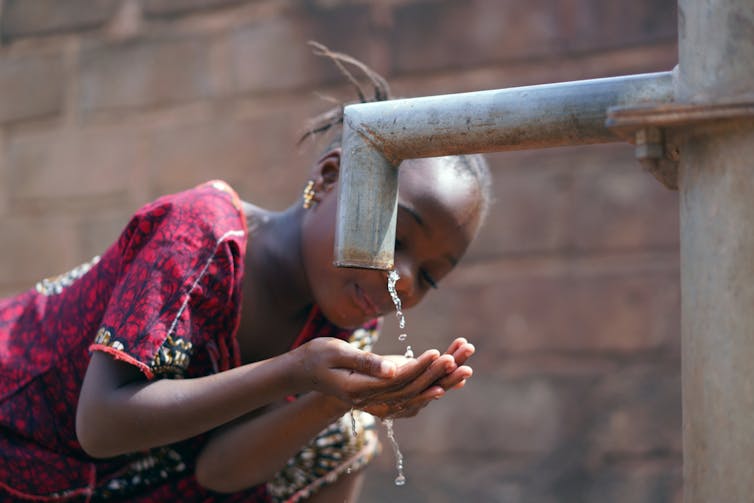
James Winter, Stanford University and Jenna Davis, Stanford University
Access to safe water is central to human health and economic development, yet most rural households in sub-Saharan Africa don’t have water piped to their home.
When women and girls are forced to spend hours each day hauling water for their households, the consequences can be devastating.
Beyond harming both physical and mental health, fetching water also takes time away from activities such as education, caregiving, gardening and employment. It’s no surprise that households that depend on distant water sources are at increased risk of child diarrhoeal disease and stunting, maternal stress and violence against women.
If the costs to women and girls of fetching water are well understood, why has there not been more progress in providing the service to homes? The reason is that installing and maintaining a piped water system is more expensive per person than a borehole and handpump, particularly in rural areas where population density is low. As a result, only one in five rural households in sub-Saharan Africa has water supply at home, compared to one out of two households living in urban areas.
The story in Zambia is no different. Just 4% of households in rural Zambia use piped water. As a result, there’s limited evidence on how much and in what way piped water can improve the lives of Zambians living in remote villages. Such information could help the government and its development partners allocate scarce financial resources towards water investments that generate the greatest benefits.
Linking time and water
Our study aimed to generate this type of evidence. To do this, we measured the impact of installing piped water systems by following four villages in a rural district of Zambia’s southern province over a period of 12 months. Halfway through the study, two of the villages received piped water systems that delivered water supply to yard taps, reducing the median distance of their water source from more than 200 metres to just 15 metres.
We hypothesised that this change could transform households’ wellbeing, by decreasing the time spent fetching water and increasing economic opportunity and food security.
In all four villages we interviewed female heads of households, collected data from GPS sensors and conducted detailed observations of the villages. We installed meters in the villages that received the piped systems to measure water use. Using data from multiple sources allowed us to get and compare different views of the effects of having piped water.
We found that households who obtained yard taps spent 80% less time fetching water than those in the control group, saving nearly four hours a week on average. The time savings accrued almost entirely to women and girls, who are the primary water fetchers in rural Zambia. When asked how gaining access to piped water affected their emotional outlook, 64% of respondents reported feeling happier, 47% reported that their families were healthier and 22% reported being less worried.
Previous studies that investigated time savings from water supply improvements concluded – often with a sense of disappointment – that women reallocated saved time towards sleep and leisure. Our position is that a woman is the best judge of how her time should be allocated. Moreover, a growing literature links inadequate sleep to a host of physical and mental health ailments, and to diminished child care quality. Based on our calculations, reducing the time cost of water fetching could help reduce these public health threats for some 2.5 million women and their children in rural Zambia.
Some households in our study who obtained piped water at home reallocated saved time to rest and leisure. The majority used it for productive activities. They reported spending more time cultivating gardens, working outside the home and caring for their families. They grew rapeseed, okra, eggplant, sweet potatoes and other crops, which they reported both consuming and selling at local markets.
Households with convenient water access were four times more likely to cultivate a garden – and their gardens were twice as large on average – compared with households who continued to use distant handpumps. By enhancing dietary diversity and household income, these gardens could support child health and household resilience.
Our findings may actually underestimate the potential impact of piped water installations in rural Zambia. Even before piped water was installed, the households in our target villages lived closer to their water source than the typical rural Zambian household, according to national surveys.
Assuming our findings can apply to other areas, changing from a community water source to a house or yard tap would save a household roughly 32 hours a month on average. This time windfall would largely go to women and girls, providing increased opportunities for work, school or leisure.
Water’s worth
Our findings underscore the importance of documenting the full range of benefits that providing safe water on premises can generate. The evidence can inform investment decisions in the sector. Along with the impacts on infectious disease that have been measured in the past, bringing water closer to households can generate benefits in the form of time savings, incremental income and improved nutrition, as our study has shown.
Piped water networks, however, are more costly and complex to install and maintain than wells and handpumps. Low and seasonal incomes in rural areas of sub-Saharan Africa can make it difficult for households to share the financial burden. Additional work is needed to identify service delivery models that can meet their needs sustainably.
James Winter, PhD Candidate, Environment Engineering and Science, Stanford University and Jenna Davis, Professor of Civil and Environmental Engineering, Stanford University
This article is republished from The Conversation under a Creative Commons license. Read the original article.

